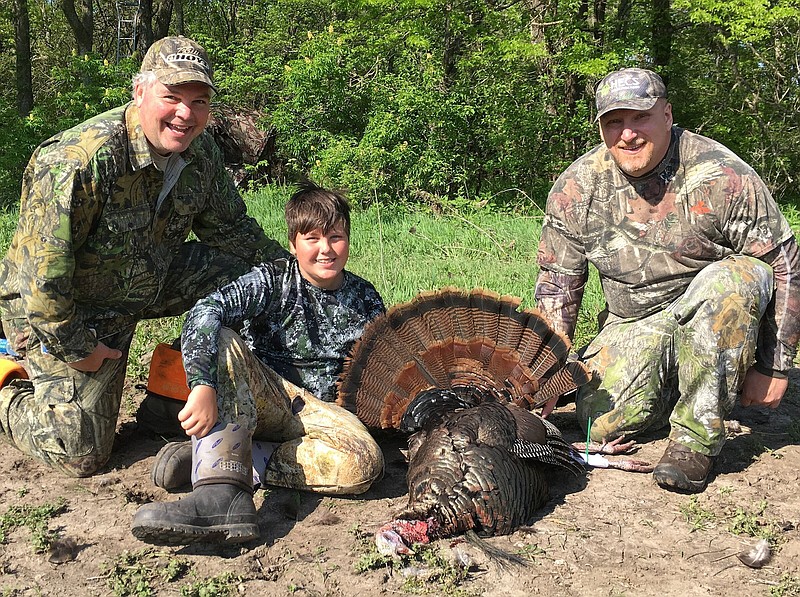Turkey season opens in just 75 days, and now is a good time to start preparing.
If you are new to turkey hunting or if you plan on using a different turkey load or a different choke tube than usual, the first thing you should do is pattern your combination. Different shotgun barrels and chokes pattern loads differently. Switching from Winchester LongBeard or Remington Nitro to Tungsten Super Shot (TSS) or HeviShot will produce a wildly different pattern. If you don't know exactly how they pattern at 20 and 40 yards, guessing might prevent you from killing a gobbler.
Also, using a better sight system than stock rib beads will help, as well. For years I used Truglo fiber optic beads with great success. I calibrated them for 45 yards with 3-inch HeviShot loads from a Winchester SX3 12-gauge and a Trulock Turkey choke. I switched to an SX3 20-gauge three years ago and TSS with a Trulock tube. The gun has a cantilever rail mount on which I mounted a Truglo dot sight. The combination is extremely effective.
TSS has about made all other projectile materials obsolete, but HeviShot and lead are still effective. Winchester LongBeard is the best of the lead loads, and HeviShot is a phenomenal projectile.
Now is also the time to sharpen your calling skills. Many of us have been blowing duck calls in our trucks for the last 60 days. You can practice blowing a turkey diaphragm call while driving, too. The acoustics in a truck cab are very good, and that environment will help you modulate tone, volume and pitch. Turkey hunters tend to call too loud in the woods believing that they need to project sound. Except for gobblers and hens making assembly calls, real turkeys vocalize softly. Turkeys can hear very well, and they can hear a soft call from a long distance.
If you are belting out a jazz solo to an undetected bird close by, you might make that bird suspicious or spook it.
Also, sharpen your calling with box calls and friction calls. Your touch will have suffered since last spring. Practice will reacquaint you with the angle that gives you the best tone with your favorite call and striker.
Box call lids often develop a glaze from scraping that will affect tone and make it harder to get a tone. A few light passes with extra fine grit sandpaper will restore the surface. Be sure to add fresh chalk.
Wild turkeys are not in the same places at the beginning of February as they will be in mid April. However, you can eliminate a lot of guesswork by watching and listening to turkeys in winter. They often follow watercourses in the winter scratching for goodies in soft soil. They also travel in large flocks in the winter. You can hear them scratching in the leaves from a distance.
These encounters are good opportunities to practice your shadowing skills. If you know where turkeys are, you can determine their route. You can loop around a flock and sit against a tree. If you are still and quiet, they'll come right to you. This will enable you to see how many mature gobblers and jakes a flock contains. You can then determine which gobblers you want to hunt. The number of jakes gives you an estimate of flock health and potential gobbler carryover for the 2025 season.
Avid deer hunters use these same tactics and principles to appraise their herd health and identify bucks that they want to hunt.
If your primarily hunt public land, preseason scouting is doubly important. Our national forests get a lot of hunting pressure, but mostly from novices that don't know the land well. Preseason scouting allows you to find strutting parlors and roost trees that are far from roads. Casual hunters don't often venture more than a couple of hundred yards from roads. Knowing remote areas will reduce the chances of somebody else spoiling your hunt.
Turkey hunting involves a lot of walking. Break in a pair of comfortable, sturdy boots over the next two months. This will reduce foot and leg fatigue, enabling you to hunt longer and harder when the season arrives.
We strongly recommend wearing snake boots. Snakes are not out much in winter, but turkey season is a prime time to encounter a venomous reptile. Snake boots can save you a ton of money and a lot of pain.
Stock up on tick repellent. The woods are rife with ticks in April and May, and their bite can transmit Rocky Mountain spotted fever and Lyme Disease. It can also trigger Alpha Gal Syndrome. We recommend Permanone. It is very potent. Douse your hunting clothes and boots with it a couple of days before your hunt. It will dry, but it will still be effective. Do not spray strong tick repellents on bare skin.
Mosquitoes are very pesky on warm spring mornings. If you hunt in South Arkansas, they'll bedevil you all day long. We always have a Thermacell in our turkey vest. I also use OFF! Botanicals bug spray on my neck and face. A mosquito bite or a gnat bite will make you flinch. A turkey will see that slight movement from a long distance and go the other direction. For that reason, repellents are wise investments.
Finally, make sure your kit is in order. Your cap, gloves, facemask, calls, vest, and other gear should all be together. This will prevent the mad search for misplaced items late on April 14.
